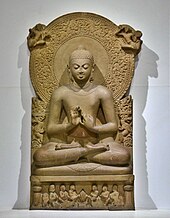Daftar dua puluh delapan Buddha: Perbedaan antara revisi
k →Referensi: + |
k perbaiki referensi |
||
| Baris 259: | Baris 259: | ||
<ref name=BealChIII>[[#refBeal1875|Beal (1875)]], Beal S, ''Chapter III: Exciting to religious sentiment'', pp. 10-17</ref> |
<ref name=BealChIII>[[#refBeal1875|Beal (1875)]], Beal S, ''Chapter III: Exciting to religious sentiment'', pp. 10-17</ref> |
||
| ⚫ | |||
| ⚫ | <ref name=Cunningham1880>{{cite book|last=Cunningham|first=A|authorlink=Alexander Cunningham|title=Report of Tours in the Gangetic Provinces from Badaon to Bihar, in 1875-76 and 1877-78|chapter=XVIII: Tandwa|pages=70–8|publisher=Office of the Superintendent of Government Printing|location=Calcutta, India|year=1880|url=http://archive.org/stream/reporttoursinga00cunngoog#page/n80/mode/1up}}</ref> |
||
<ref name=Davids1878>{{cite book|last=Davids|first=TWR|last2=Davids|first2=R|authorlink=Thomas William Rhys Davids|title=Buddhist birth-stories; Jataka tales. The commentarial introduction entitled Nidana-Katha; the story of the lineage|chapter=The successive bodhisats in the times of the previous Buddhas|pages=115–44|publisher=George Routledge & Sons|location=London|year=1878|url=http://archive.org/stream/buddhistbirth00daviuoft#page/n132/mode/1up}}</ref> |
<ref name=Davids1878>{{cite book|last=Davids|first=TWR|last2=Davids|first2=R|authorlink=Thomas William Rhys Davids|title=Buddhist birth-stories; Jataka tales. The commentarial introduction entitled Nidana-Katha; the story of the lineage|chapter=The successive bodhisats in the times of the previous Buddhas|pages=115–44|publisher=George Routledge & Sons|location=London|year=1878|url=http://archive.org/stream/buddhistbirth00daviuoft#page/n132/mode/1up}}</ref> |
||
<ref name=Ghosh1987>{{cite journal|last=Ghosh|first=B|title=Buddha Dīpankara: twentyfourth predecessor of Gautama|journal=Bulletin of Tibetology|volume=11 (new series)|issue=2|pages=33–8|year=1987|issn=0525-1516|url=http://himalaya.socanth.cam.ac.uk/collections/journals/bot/pdf/bot_1987_02_03.pdf}}</ref> |
<ref name=Ghosh1987>{{cite journal|last=Ghosh|first=B|title=Buddha Dīpankara: twentyfourth predecessor of Gautama|journal=Bulletin of Tibetology|volume=11 (new series)|issue=2|pages=33–8|year=1987|issn=0525-1516|url=http://himalaya.socanth.cam.ac.uk/collections/journals/bot/pdf/bot_1987_02_03.pdf}}</ref> |
||
| ⚫ | <ref name=Huntington>{{cite web|author=|title=Life of the Buddha: Dīpankara's Prediction of Enlightenment|work=|publisher=The Huntington Archive - The Ohio State University|location=|year=|url=http://huntingtonarchive.osu.edu/studypages/internal/dl/SouthAsia/Buddhist/pgs/u5/DL0208m.htm|accessdate=2012-09-06}}</ref> |
||
<ref name=jatakaonline>[http://www.jatakaonline.com/jataka-tales/00110-prophecies-of-kakusandha-buddha-konagamana-buddha-and-kassapa-buddha Prophecies of Kakusandha Buddha, Konagamana Buddha and Kassapa Buddha]</ref> |
<ref name=jatakaonline>[http://www.jatakaonline.com/jataka-tales/00110-prophecies-of-kakusandha-buddha-konagamana-buddha-and-kassapa-buddha Prophecies of Kakusandha Buddha, Konagamana Buddha and Kassapa Buddha]</ref> |
||
| Baris 274: | Baris 268: | ||
<ref name=Malalasekera319>[[#refMalalasekera2007|Malalasekera (2007)]], Malalasekera GP, ''Bodhirukka'', p. 319</ref> |
<ref name=Malalasekera319>[[#refMalalasekera2007|Malalasekera (2007)]], Malalasekera GP, ''Bodhirukka'', p. 319</ref> |
||
<ref name=Malalasekera294>[[#refMalalasekera2007|Malalasekera (2007)]], Malalasekera GP, ''Buddha'', pp. 294-305</ref> |
<ref name=Malalasekera294>[[#refMalalasekera2007|Malalasekera (2007)]], Malalasekera GP, ''Buddha'', pp. 294-305</ref> |
||
| ⚫ | |||
<ref name=Malalasekera131>[[#refMalalasekera2007|Malalasekera (2007)]], Malalasekera GP, ''Paduma'', p. 131</ref> |
|||
| ⚫ | <ref name=Cunningham1880>{{cite book|last=Cunningham|first=A|authorlink=Alexander Cunningham|title=Report of Tours in the Gangetic Provinces from Badaon to Bihar, in 1875-76 and 1877-78|chapter=XVIII: Tandwa|pages=70–8|publisher=Office of the Superintendent of Government Printing|location=Calcutta, India|year=1880|url=http://archive.org/stream/reporttoursinga00cunngoog#page/n80/mode/1up}}</ref> |
||
<ref name=Malalasekera136>[[#refMalalasekera2007|Malalasekera (2007)]], Malalasekera GP, ''Padumuttara'', pp. 136-7</ref> |
|||
| ⚫ | <ref name=Huntington>{{cite web|author=|title=Life of the Buddha: Dīpankara's Prediction of Enlightenment|work=|publisher=The Huntington Archive - The Ohio State University|location=|year=|url=http://huntingtonarchive.osu.edu/studypages/internal/dl/SouthAsia/Buddhist/pgs/u5/DL0208m.htm|accessdate=2012-09-06}}</ref> --> |
||
<ref name=Malalasekera207>[[#refMalalasekera2007|Malalasekera (2007)]], Malalasekera GP, ''Piyadassi'', p. 207</ref> |
|||
<ref name=Malalasekera257>[[#refMalalasekera2007|Malalasekera (2007)]], Malalasekera GP, ''Phussa'', p. 257</ref> |
|||
<ref name=Malalasekera754>[[#refMalalasekera2007|Malalasekera (2007)]], Malalasekera GP, ''Revata'', pp. 754-5</ref> |
|||
}} |
}} |
||
== Pranala luar == |
== Pranala luar == |
||
* Vipassana.info: [http://www.vipassana.info/dic_idx.html Pali Proper Names Dictionary] |
* Vipassana.info: [http://www.vipassana.info/dic_idx.html Pali Proper Names Dictionary] |
||
* <span id="refBeal1875" class="citation">{{cite book|last=Beal|first=S|authorlink=Samuel Beal|title=The romantic legend of Sâkya Buddha: from the Chinese-Sanscrit|publisher=Trubner & Company, Ludgate Hill|location=London|year=1875|url=http://archive.org/stream/cu31924023164209#page/n5/mode/2up}}</span> |
|||
* <span id="refMalalasekera2007" class="citation">{{cite book|last=Malalasekera|first=GP|authorlink=Gunapala Piyasena Malalasekera|title=Dictionary of Pāli proper names|publisher=Motilal Banarsidass Publishers Private Limited|location=Delhi, India|year=2007|isbn=978-81-208-3020-2|url=http://books.google.com/?id=8Au_lIP1ZnQC&printsec=frontcover&dq=inauthor:%22Gunapala+Piyasena+Malalasekera%22#v=onepage&q&f=false}}</span> |
|||
{{Topik Buddhisme}} |
{{Topik Buddhisme}} |
||
Revisi per 1 Agustus 2014 04.07
| Bagian dari seri tentang |
| Buddhisme |
|---|
 |
Di negara-negara dimana Buddhisme Theravada dianut oleh mayoritas masyarakat (Sri Lanka, Kamboja, Laos, Myanmar, Thailand), merupakan hal yang lazim bagi umat Buddhis untuk menyelenggarakan perayaan-perayaan, terutama selama musim yang baik, guna menghormati 29 Buddha.
Penghormatan para Buddha ini termasuk 28 Buddha sebagaimana dijelaskan pada Bagian 27 dalam Buddhavamsa, ditambah Bodhisattva Maitreya, Buddha (ke-29) mendatang. Buddhavamsa adalah sebuah naskah yang menjelaskan kehidupan Buddha Gautama dan dua-puluh-tujuh Buddha sebelumnya. Buddhavamsa adalah bagian dari Khuddaka Nikaya, yang kemudian merupakan bagian dari Sutta Pitaka. Sutta Pitaka merupakan satu dari tiga bagian dari Kanon Pali agama Buddha Theravada.
28 Buddha dikatakan telah mencapai pencerahan mulai dari waktu Buddha Gautama menerima Niyatha Vivarana pertamanya (persetujuan untuk menjadi yang tercerahkan berikutnya) dari Buddha Dīpankara.
Buddha-Buddha yang telah ada sebelumnya bukan hanya berjumlah 28 Buddha. Sesungguhnya, Buddha Gautama telah menyampaikan jumlah Buddha yang tidak terhingga yang telah hidup beberapa kalpa lalu.



Nama 28 Buddha
| Nama Pāli[1][2] | Kasta[2] | Tempat lahir[2] | Orang tua[2] | Bodhirukka (tree of enlightenment)[2][3] | ||
|---|---|---|---|---|---|---|
| 1 | Taṇhaṅkara[4] | King Sunandha, and Queen Sunandhaa | Rukkaththana | |||
| 2 | Medhaṅkara[5] | Sudheva, and Yasodhara | Kaela | |||
| 3 | Saraṇaṅkara[6] | Sumangala, and Yasawathi | Pulila | |||
| 4 | Dīpankara[7] | Brahmin[8] | Rammawatinagara | Sudheva, and Sumedhaya | Pipphala | Sumedha (also Sumati or Megha Mānava, a rich Brahman)[9] |
| 5 | Koṇḍañña[10] | Kshatriya[8] | Rammawatinagara | Sunanda, and Sujata | Salakalyana | Vijitawi (a Chakravarti in Chandawatinagara of Majjhimadesa) |
| 6 | Maṅgala[11] | Brahmin[8] | Uttaranagara (Majhimmadesa) | Uttara, and Uttara | a naga | Suruchi (in Siribrahmano) |
| 7 | Sumana[12] | Kshatriya[8] | Mekhalanagara | Sudassana and Sirima | a naga | King Atulo, a Naga |
| 8 | Revata[13] | Brahmin[8] | Sudhannawatinagara | Vipala and Vipula | a naga | A Veda-versed Brahman |
| 9 | Sobhita[14] | Kshatriya[8] | Sudhammanagara | Sudhammanagara (father) and Sudhammanagara (mother) | a naga | Sujata, a Brahman (in Rammavati) |
| 10 | Anomadassi[15] | Brahmin[8] | Chandawatinagara | Yasava and Yasodara | ajjuna | A Yaksha king |
| 11 | Paduma[16] | Kshatriya[8] | Champayanagara | Asama, and Asama | salala | A lion |
| 12 | Nārada[17] | Dhammawatinagara | King Sudheva and Anopama | sonaka | a tapaso in Himalayas | |
| 13 | Padumuttara[18] | Kshatriya | Hansawatinagara | Anurula, and Sujata | salala | Jatilo an ascetic |
| 14 | Sumedha[19] | Kshatriya | Sudasananagara | Sumedha (father), and Sumedha (mother) | nipa | Native of Uttaro |
| 15 | Sujāta[20] | Sumangalanagara | Uggata, and Pabbavati | welu | a chakravarti | |
| 16 | Piyadassi[21] | Sudannanagara | Sudata, and Subaddha | kakudha | Kassapa, a Brahmin (at Siriwattanagara) | |
| 17 | Atthadassi[22] | Kshatriya | Sonanagara | Sagara and Sudassana | champa | Susino, a Brahman |
| 18 | Dhammadassī[23] | Kshatriya | Surananagara | Suranamaha, and Sunanada | bimbajala | Indra, the leader of the gods (devas) |
| 19 | Siddharttha[24] | Vibharanagara | Udeni, and Suphasa | kanihani | Mangal, a Brahman | |
| 20 | Tissa[25] | Khemanagara | Janasando, and Paduma | assana | King Sujata of Yasawatinagara | |
| 21 | Phussa[26] | Kshatriya | Kasi | Jayasena, and Siremaya | amalaka | Vijitavi |
| 22 | Vipassī[27] | Kshatriya | Bandhuvatinagara | Vipassi (father), and Vipassi (mother) | patali | King Atula |
| 23 | Sikhī[28] | Kshatriya | Arunavattinagara | Arunavatti, and Paphavatti | pundariko | Arindamo (at Paribhuttanagara) |
| 24 | Vessabhū[29] | Kshatriya | Anupamanagara | Suppalittha, and Yashavati | sala | Sadassana (in Sarabhavatinagara) |
| 25 | Kakusandha[30] | Brahmin | Khemavatinagara | Agidatta the purohitta Brahman of King Khema, and Visakha | airisa | King Khema[31] |
| 26 | Koṇāgamana[32] | Brahmin[33] | Sobhavatinagara | Yannadatta the Brahman, and Uttara | udumbara | King Pabbata of a mountainous area in Mithila |
| 27 | Kassapa[34] | Brahmin | Baranasinagara | Brahmadatta a Brahman, and Dhanavati | nigroda | Jotipala (at Vappulla) |
| 28 | Gautama[35] | Kshatriya | Kapilavastu | King Suddhodana, and Maya | peepal a.k.a. fig (Ficus religiosa) |
Lihat pula
Referensi
- ^ Malalasekera (2007), Malalasekera GP, Buddha, pp. 294-305
- ^ a b c d e Davids, TWR; Davids, R (1878). "The successive bodhisats in the times of the previous Buddhas". Buddhist birth-stories; Jataka tales. The commentarial introduction entitled Nidana-Katha; the story of the lineage. London: George Routledge & Sons. hlm. 115–44.
- ^ Malalasekera (2007), Malalasekera GP, Bodhirukka, p. 319
- ^ Vipassana.info, Pali Proper Names Dictionary: Taṇhaṅkara
- ^ Vipassana.info, Pali Proper Names Dictionary: Medhaṅkara
- ^ Vipassana.info, Pali Proper Names Dictionary: Saraṇaṅkara
- ^ Vipassana.info, Pali Proper Names Dictionary: Dīpankara
- ^ a b c d e f g h Beal (1875), Beal S, Chapter III: Exciting to religious sentiment, pp. 10-17
- ^ Ghosh, B (1987). "Buddha Dīpankara: twentyfourth predecessor of Gautama" (PDF). Bulletin of Tibetology. 11 (new series) (2): 33–8. ISSN 0525-1516.
- ^ Vipassana.info, Pali Proper Names Dictionary: Koṇḍañña
- ^ Vipassana.info, Pali Proper Names Dictionary: Maṅgala
- ^ Vipassana.info, Pali Proper Names Dictionary: Sumana
- ^ Vipassana.info, Pali Proper Names Dictionary: Revata
- ^ Vipassana.info, Pali Proper Names Dictionary: Sobhita
- ^ Vipassana.info, Pali Proper Names Dictionary: Anomadassi
- ^ Vipassana.info, Pali Proper Names Dictionary: Paduma
- ^ Vipassana.info, Pali Proper Names Dictionary: Nārada
- ^ Vipassana.info, Pali Proper Names Dictionary: Padumuttara
- ^ Vipassana.info, Pali Proper Names Dictionary: Sumedha
- ^ Vipassana.info, Pali Proper Names Dictionary: Sujāta
- ^ Vipassana.info, Pali Proper Names Dictionary: Piyadassi
- ^ Vipassana.info, Pali Proper Names Dictionary: Atthadassi
- ^ Vipassana.info, Pali Proper Names Dictionary: Dhammadassī
- ^ Vipassana.info, Pali Proper Names Dictionary: Siddhattha
- ^ Vipassana.info, Pali Proper Names Dictionary: Tissa
- ^ Vipassana.info, Pali Proper Names Dictionary: Phussa
- ^ Vipassana.info, Pali Proper Names Dictionary: Vipassī
- ^ Vipassana.info, Pali Proper Names Dictionary: Sikhī
- ^ Vipassana.info, Pali Proper Names Dictionary: Vessabhū
- ^ Vipassana.info, Pali Proper Names Dictionary: Kakusandha
- ^ Prophecies of Kakusandha Buddha, Konagamana Buddha and Kassapa Buddha
- ^ Vipassana.info, Pali Proper Names Dictionary: Koṇāgamana
- ^ Barua, A (2008). Dīgha-Nikāya: romanize Pāli text with English translation. 2 (edisi ke-1st). Delhi, India: New Bharatiya Book Corporation. hlm. 6. ISBN 81-8315-096-9.
- ^ Vipassana.info, Pali Proper Names Dictionary: Kassapa
- ^ Vipassana.info, Pali Proper Names Dictionary: Gotama
Pranala luar
- Vipassana.info: Pali Proper Names Dictionary
- Beal, S (1875). The romantic legend of Sâkya Buddha: from the Chinese-Sanscrit. London: Trubner & Company, Ludgate Hill.
- Malalasekera, GP (2007). Dictionary of Pāli proper names. Delhi, India: Motilal Banarsidass Publishers Private Limited. ISBN 978-81-208-3020-2.
